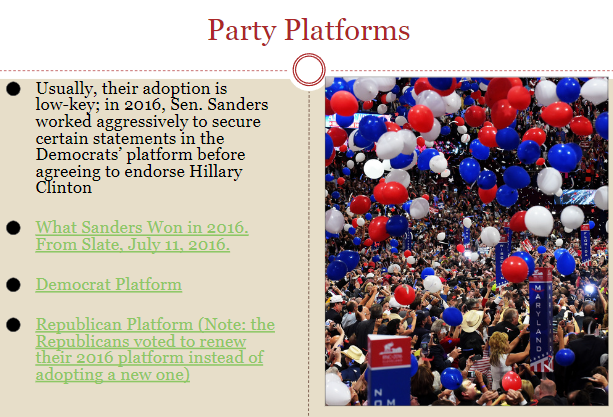Final_Exam_Review_Sheet_Section_12568.docx
FED - Chapter 8: Political Participation and Voting (also see slides)
- Types of political participation
- Protest
- Traditional political participation
- digital political participation
- suffrage
- insurrection
- Overall turnout levels including how American turnout compares with that of other countries
- America’s overall rate of voting participation, or turnout remains moderate: the US ranked 32nd in voter turnout among developed countries in 2016. Yet Americans voted in record numbers in the 2020 presidential election, with 67 percent of eligible citizens voting. While this is still lower than voting rates in the most recent elections in some other democracies, 2020 marked a high level of participation in US politics.
- Effects of turnout on policy, i.e. why do we care who votes and who doesn’t vote?
- Lower voter turnout in some contests (especially local elections) coupled with unequal participation rates can result in the election of candidates who don’t reflect the interest of most citizens, government policies that benefit wealthy voters over the middle and lower classes, and lower trust in government.
- Using info. to predict election outcomes
- Politicians are more likely to be beholden to voters (and GRPs who vote @ high rates) than nonvoters
- Could some Americans fall for foreign influences?
- Knowing who votes
- Lower voter turnout in some contests (especially local elections) coupled with unequal participation rates can result in the election of candidates who don’t reflect the interest of most citizens, government policies that benefit wealthy voters over the middle and lower classes, and lower trust in government.
- GOTV (get-out-the-vote)
- Refers to a collection of actions and programs designed to encourage people to vote in elections. It involves tactics such as door-to-door canvassing, phone calls, and internet outreach to inform and encourage voters. The objective is to increase voter participation and guarantee that more eligible people take part in the political process. GOTV initiatives typically peak on Election Day and use a variety of tactics to engage and organize potential voters.
- Know how these factors impact one’s likelihood of voting:
- Age:
- Old people vote more than young people
- Education:
- People with higher education participate in politics more
- Income
- People that make more money participate in politics more
- Race
- Black Americans tend to vote at high rates, and typically vote for Democratic candidates.
- White Americans are the largest portion of the vote and have the same rates as Black Americans. White Americans are more likely to vote for Republican candidates.
- Political efficacy (believing that politicians care what you think, that you can “make a difference,” and that you know enough to do so)
- Age:
Internal Political Efficacy | External Political Efficacy |
|---|---|
how confident a person is in their capacity to comprehend and take part in politics. | whether or not a person feels the political system reacts to their input. |
- Constitutional amendments pertaining to voting: 15th, 19th, 23rd, 24th and 26th
- 15th Amendment (1870) – Black males, 21+; Voting Rights Act of 1965 helped enforce it
- 19th Amendment (1920) – Women
- 23rd Amendment (1961) – Washington, D.C. residents
- 24th Amendment (1964) – Poll taxes outlawed
- 26th Amendment (1971) – 18-20 year olds
- Voter registration and voting laws (How do these work? Does TX have them? How do they affect overall turnout levels? Why do people support/oppose them?)
- Motor voter-(national voter registration act)
- Combines voter registration with other bureaucratic tasks
- AKA Motor Voter
- DMV and voter registration in one
- Also allows registration at public assistance agencies
- Intended to help reduce the registration requirement
- Election day vs. same day registration
- Motor voter-(national voter registration act)
Election Day Registration (EDR) | Same Day Registration (SDR) |
|---|---|
No closing date; just register at your polling place | Registering and voting before the election
|
- Early voting (Texas has this; who can use it?)
- Being able to vote in person before Election Day without having to offer an excuse
- Any registered voter in Texas may vote early in person for any reason
- In Texas, during the presidential general election, the early voting period ran from Tuesday, October 13 to Friday, October 30
- Rules, procedures, and eligibility for early voting vary across states
- States with Early Voting in 2020, Source: National Council of State Legislatures
- According to the Census Bureau, about 31.6 percent of ballots cast in 2012 were cast early; thus, early voting had become popular long before the pandemic
- Being able to vote in person before Election Day without having to offer an excuse
- Closing date (last day to complete voter registration to vote in an upcoming election) (deadline to register to vote in a particular election; in TX, it’s 30 days)
- Absentee voting (voting by mail)
- Early voting (Texas has this; who can use it?)
Voting During Pandemic | VBM Challenges |
|---|---|
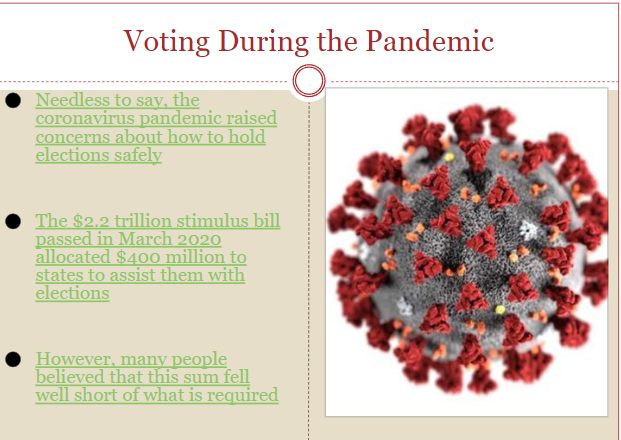 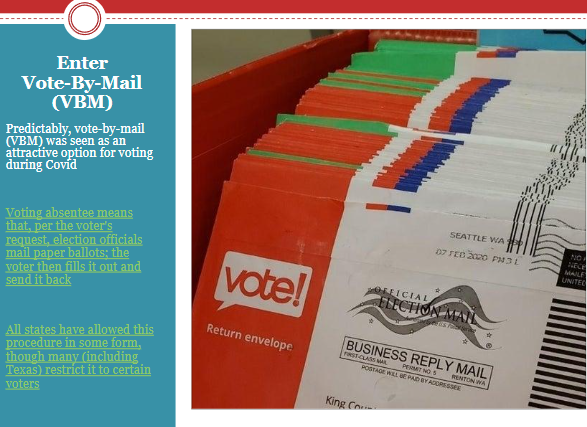 | 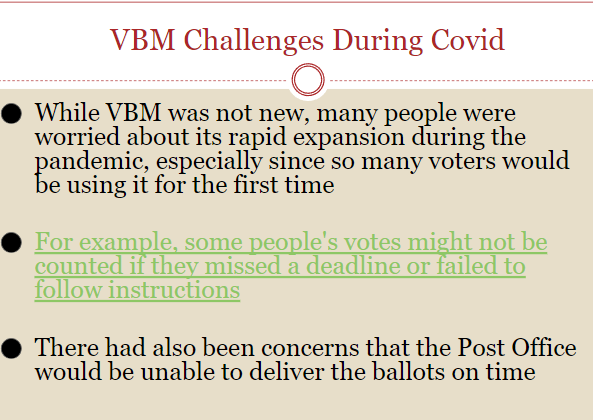 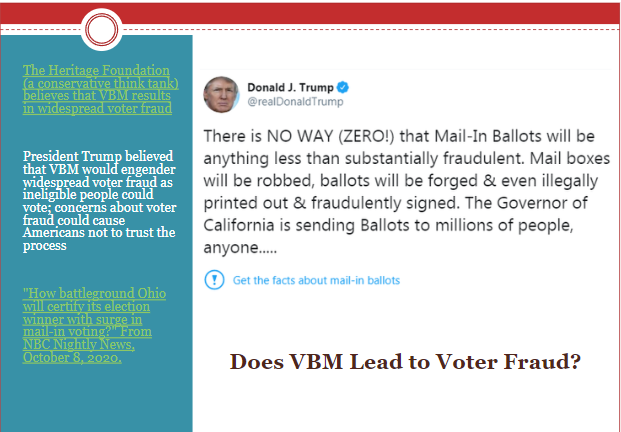 |
Voting by Mail in Texas | |
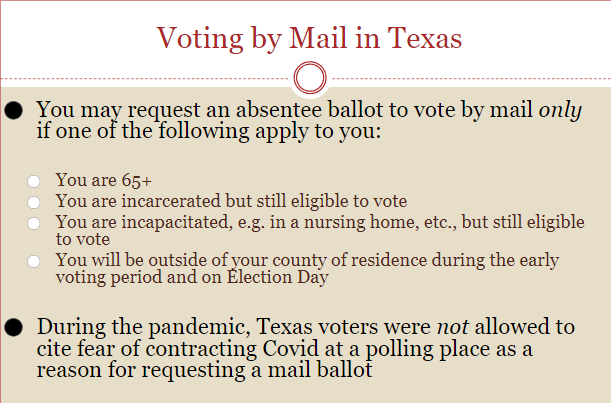 |
For the People | Freedom to Vote |
|---|---|
Meanwhile, in early March 2021, the US House of Representatives passed the For the People Act (they had also done so in 2019); among other things, the bill would have:
The bill needed Senate approval, which never happened | 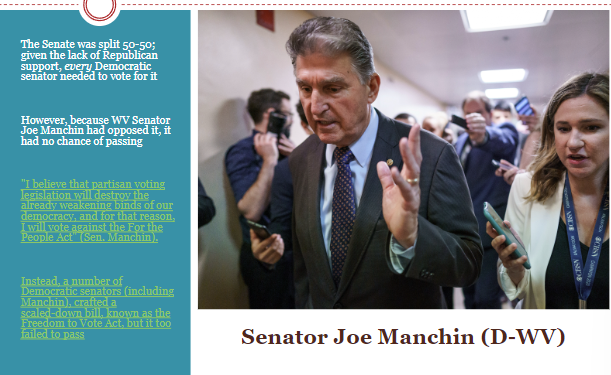 |
John Lewis Voting Rights Advancement | |
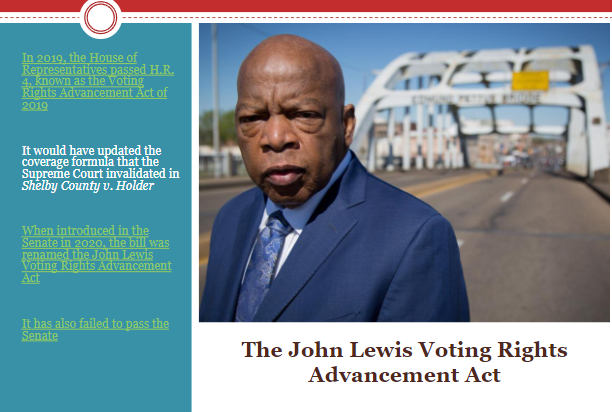 |
- Shelby County v. Holder
- However, in Shelby County v. Holder (2013), the Supreme Court ruled 5-4 that the coverage formula was outdated and therefore unenforceable
- This decision has paved the way for states to pass & enforce controversial election laws for which preclearance had earlier been denied, including photo ID laws & myriad laws that states have enacted in 2020
- Laws requiring photo IDs to vote
- Arguments for and against these law
- Photo ID requirements upheld in Crawford v. Marion County Election Board (2008)
- Arguments for and against these law
Democrats (Against) | Republicans (For) |
|---|---|
Worries that minorities, college students & the elderly (who are less likely to have photo IDs) would be unable to vote | Concerns about voter fraud & the overall integrity of the electoral process |
- Acceptable photo IDs to vote in TX
- This page from the Texas Secretary of State explains what photo IDs may be used and how to obtain one
- Texas Driver License issued by the Texas Department of Public Safety (DPS)
- Texas Election Identification Certificate issued by DPS
- Texas Personal Identification Card issued by DPS
- Texas Handgun License issued by DPS
- United States Military Identification Card containing the person’s photograph
- United States Citizenship Certificate containing the person’s photograph
- United States Passport (book or card)
- Acceptable photo IDs to vote in TX
- Impact of Voting Rights Act of 1965 on turnout
- The Voting Rights Act of 1965 required certain jurisdictions to receive preclearance from the U.S. Department of Justice before they could change their election laws and voting procedures, locations, etc.
- Such jurisdictions (states, counties, etc.) had histories of racial discrimination in voting, and the law contained a coverage formula to determine which jurisdictions would be subject to the preclearance requirement
- This requirement prevented Southern states from enacting photo ID laws
- Recent efforts to change voting laws
Georgia | Texas |
|---|---|
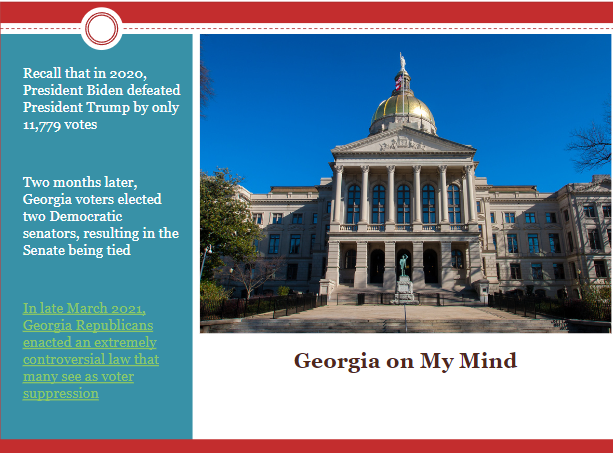 | 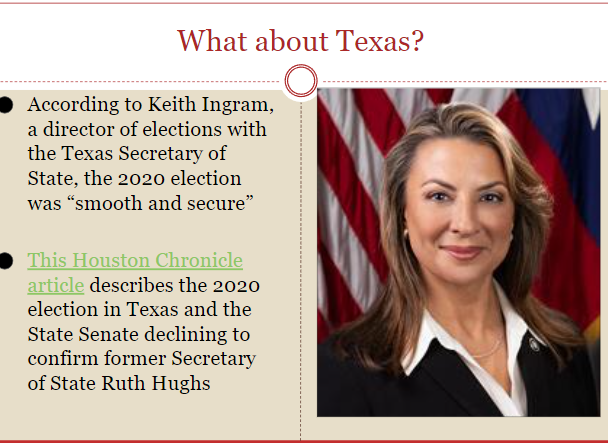 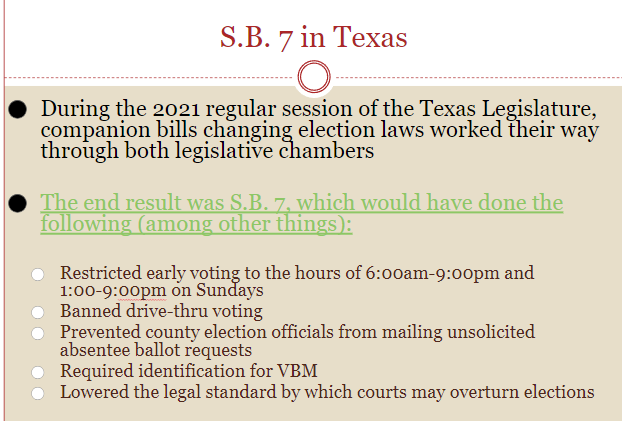 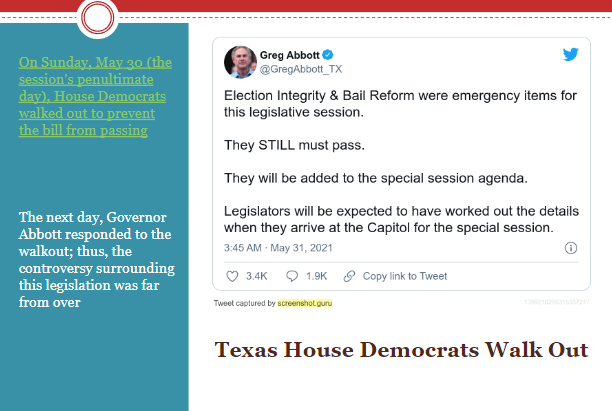 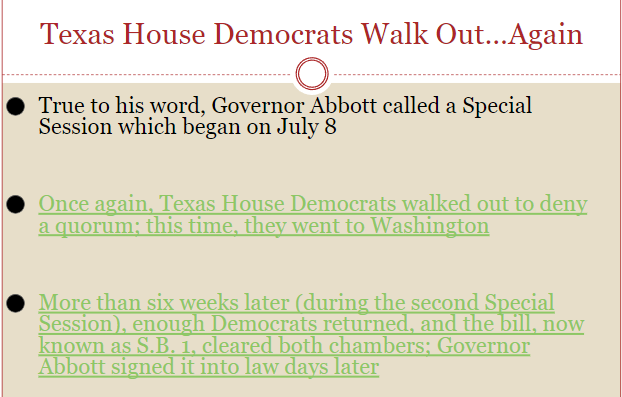 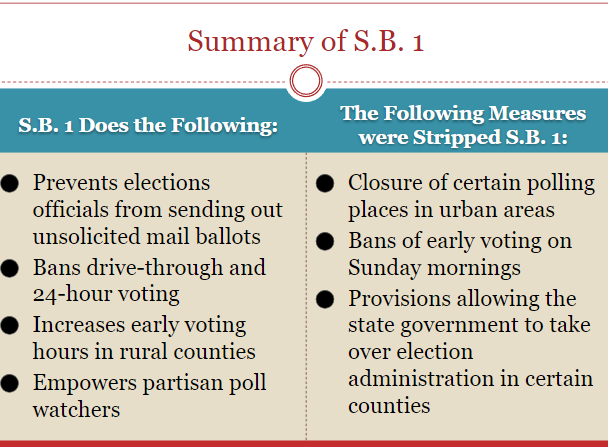 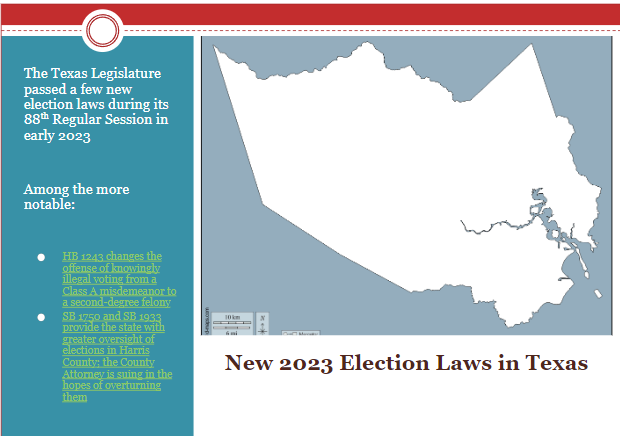 |
- How voters decide
- Prospective voting
- Make judgments based on their expectations of a candidate's future performance. Voters assess the candidate's planned ideas and intentions rather than the candidate's prior actions or record. They vote because they believe the chosen candidate will result in beneficial consequences in the future.
- Retrospective voting
- Make judgments based on a candidate's or the incumbent party's prior performance. Voters evaluate how successfully a candidate or party handled issues in the past and use that assessment to decide whether to support or reject them in the current election. Rather than focusing on future promises, this method looks back at past deeds.
- Rational abstention thesis
- People may choose not to vote when the perceived costs of voting, such as time and effort, outweigh the expected benefits. According to this hypothesis, voters may choose not to vote if they feel their vote will have little influence on the result of the election.
- Prospective voting
FED – Chapter 10: Campaigns and Elections (also see slides)
People vote for delegates to attend the conventions
| People go to meetings to adopt party platforms and select candidates
|
|---|---|
General Election | Primary Election |
face-off between candidates from the 2 parties. | to choose the candidate to participate in the general election |
Open Primaries | Closed Primaries |
|---|---|
Voters may choose the party primary in which they wish to participate (they obviously can’t participate in more than one)
| Some states have closed primaries; these primaries restrict to participation to voters registered with the respective parties
|
Semi-Open Primaries (Hybrid/Modified primaries) | |
Restrict partisans to participating in the primary of the party with which they are registered
|
- Presidential nomination process:
- Frontloading
- Moving caucuses & primaries up so states have more say in who gets nominated
- Super delegates
- Frontloading
Who are they? | Why are they so controversial? | |
|---|---|---|
| 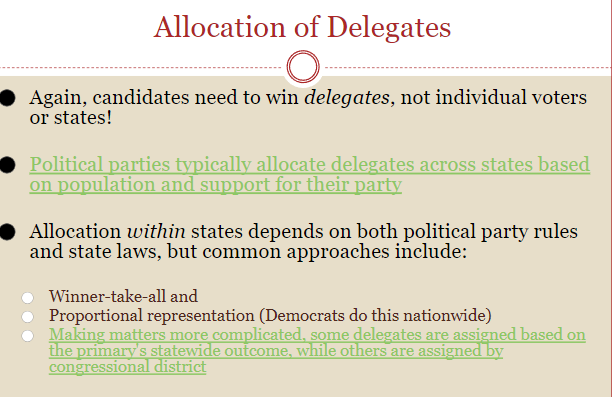 | |
What are the new rules concerning them? | ||
Obligations of Delegates | Democratic Superdelegate | |
Pledged to support one candidate
| Controversial at-large delegates (no one votes for them) who are free to vote for whomever they wish | |
- Texas primary (Texas holds an open primary on Super Tuesday)
- The Texas primary occurred on Tuesday, March 3
- Because 1,357 delegates are up for grabs (TX has 228), this day is known as Super Tuesday
- Texas has an open primary (though they will record which party you choose)
- 2016 Texas primary winners:
- Hillary Clinton
- Ted Cruz
- 2020 Texas primary winners:
- Joe Biden
- Donald Trump (uncontested)
- Texas primary (Texas holds an open primary on Super Tuesday)
- General election campaign
- Conventions
History | Purpose |
|---|---|
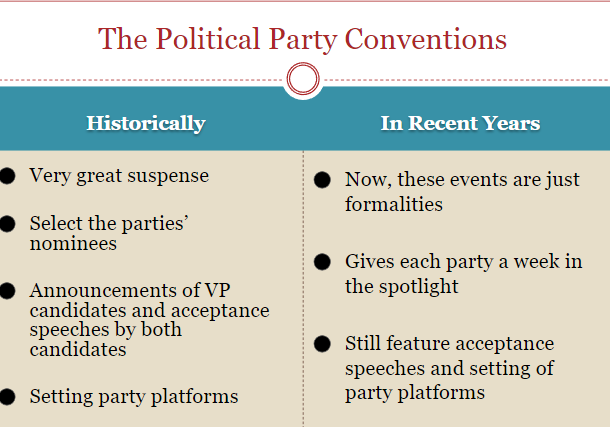 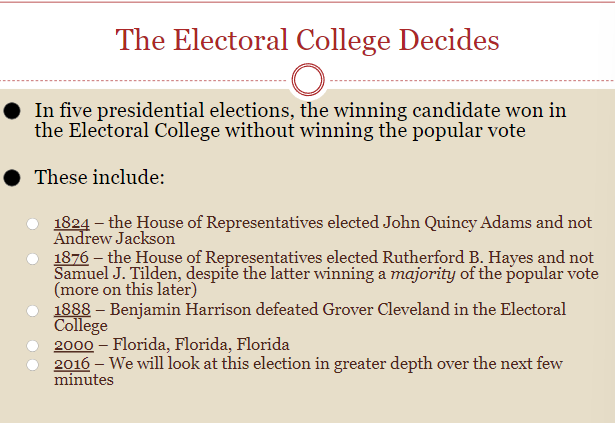 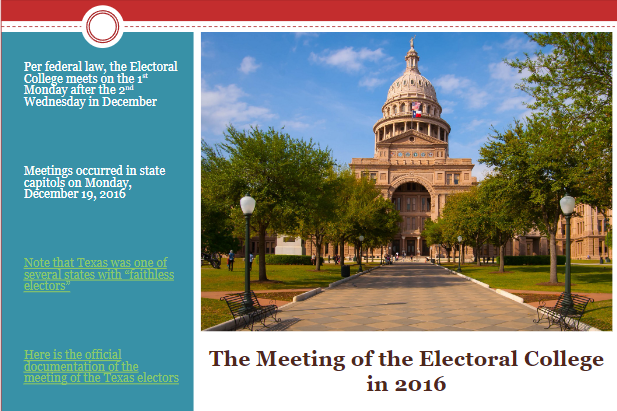 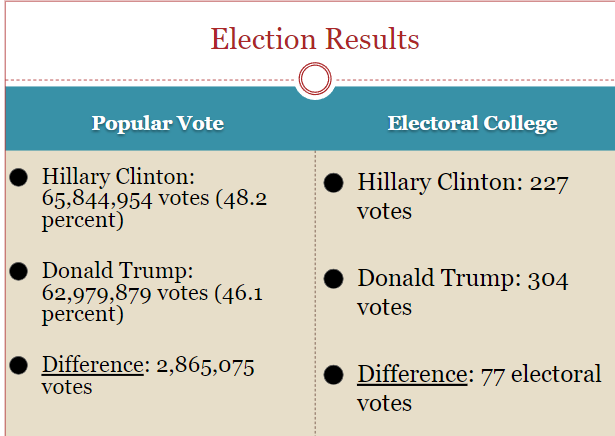 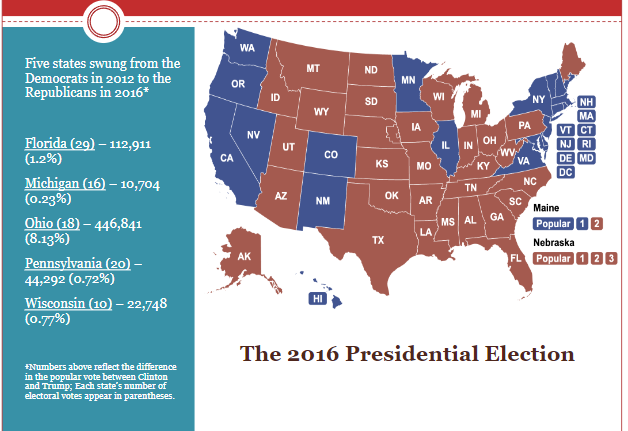 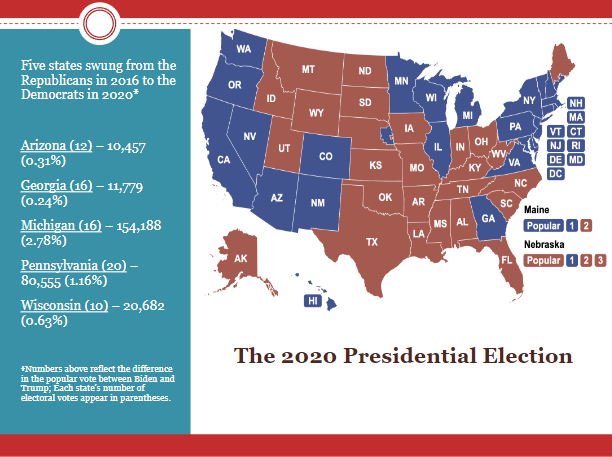 | 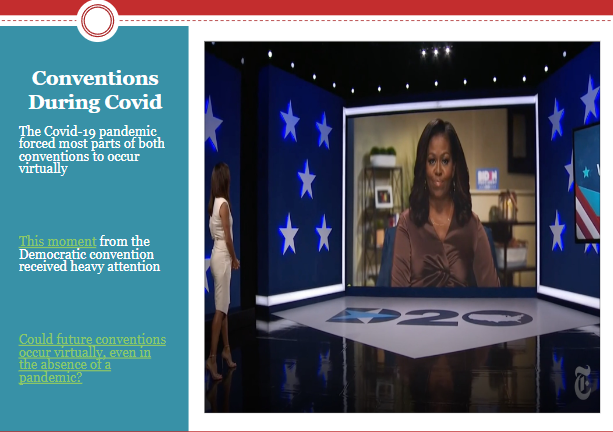 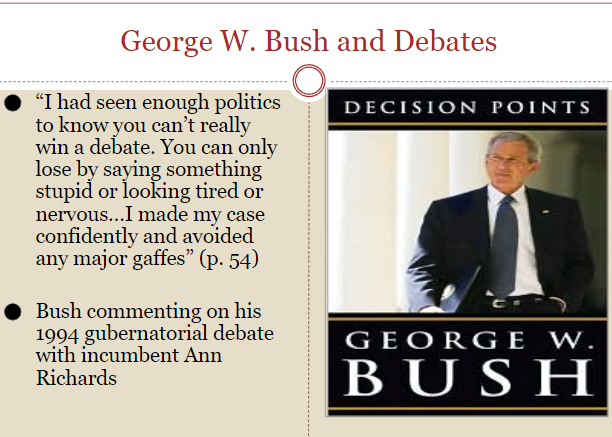 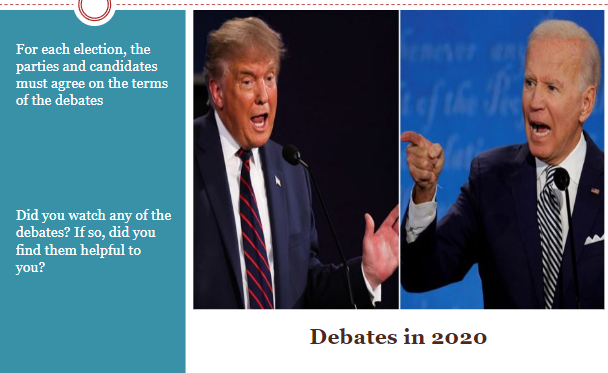 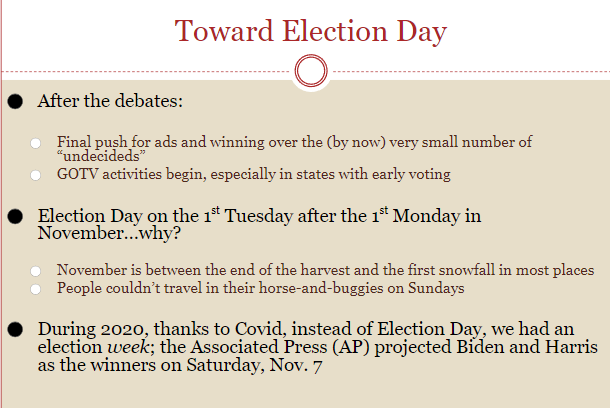 |
importance of party platforms | |
|
- Electoral College
- Reasons people support its retention and removal
- Electoral College
Why Keep It? | Why Abolish It? |
|---|---|
|
|
- How are the numbers of electoral votes allocated among the states?
- Each state receives electoral votes in proportion to the number of Representatives and Senators it has in Congress. The number of Representatives is determined by the population of the state, with a minimum of one. Each state has two Senators, which gives them a starting point of two electoral votes. To win the presidency, a candidate must receive a majority of these electoral votes, which totals 270 out of 538.
- Where does the Electoral College meet? Why there?
- The Electoral College convenes in each state and the District of Columbia, rather than in a single location. On the first Monday following the second Wednesday in December, they convene at the state capital, which is decided by the state assembly. This decentralized procedure emphasizes the importance of each state in the election, with electors from each state casting separate ballots.
- Must states allocate electoral votes winner-take-all?
- States can decide how to distribute their electoral votes. Most employ a winner-take-all method, however, some apportion votes depending on popular vote proportion. Maine and Nebraska use a separate mechanism that takes into account both statewide and district-level votes. It is determined by the laws and preferences of each state.
- How are the numbers of electoral votes allocated among the states?
Proportional Representation | Winner-Take-All |
|---|---|
An electoral system in which parties gain seats in proportion to the # of votes cast for them. | An electoral system in which the party that receives at least one more vote than any other party wins the election. |
- Are there faithless electors?
- Faithless electors are members of the Electoral College who do not vote for the candidate they are meant to vote for. Some states have laws in place to prevent this, and the Supreme Court has upheld the jurisdiction of states to enforce such regulations. Although disloyal voters are infrequent, there are policies in place to combat and prohibit such behavior.
- Certification of Electoral College votes
- Are there faithless electors?
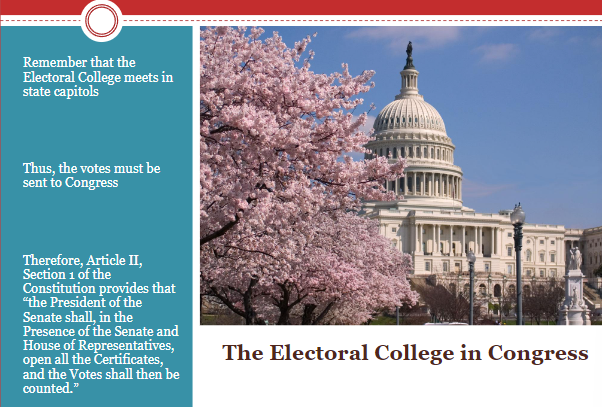
- Know the outcomes of the most significant midterm elections
FED – Chapter 11: Groups and Interests (also see slides)
- Interest group
- Individuals who organize to influence the government’s programs and policies ” (from your textbook)
- Public policy includes:
- Influencing who comprises the government
- Their actions (and inactions)
- Examples:
Educating the General Public | Facilitating Political Participation |
|---|---|
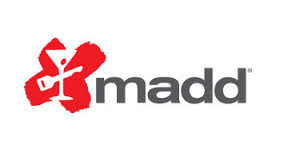 |
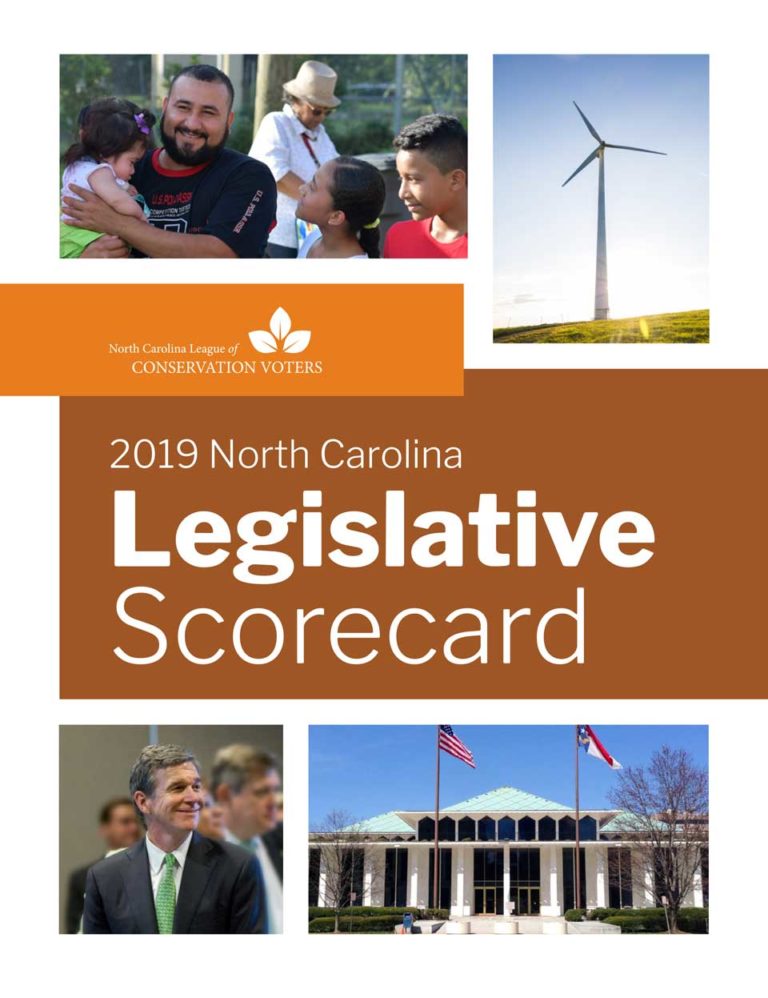 |
- Benefits obtained from interest group membership:
Solidary incentives | Purposive benefits |
|---|---|
Benefits that people receive from interacting with (and forming friendships with) like-minded individuals
| Satisfaction you get from working on a cause
|
Economic benefits | |
Interest groups are often quite successful in getting what they want!
|
- Free rider
- Often known as “collective action problems”
- Social pressure (think of small groups)
- Trying to make your contributions more personal, e.g. Sarah McLachlan SPCA Commercial
- Selective benefits: ex. AARP (American Association of Retired Persons)
- Often known as “collective action problems”
- Elite and pluralist theories of interest groups
Elitist | Pluralist |
|---|---|
| Theory that holds that policymaking is a competition among diverse interest groups that ensure the representation of individual interests
|
Activities of interest groups concerning gun control | Recent Virginia elections and their outcomes |
|---|---|
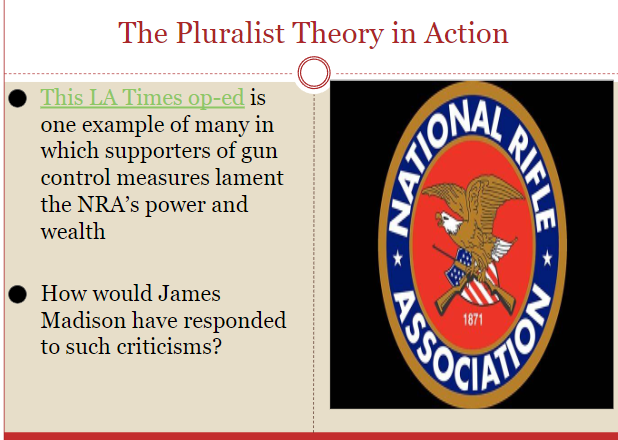 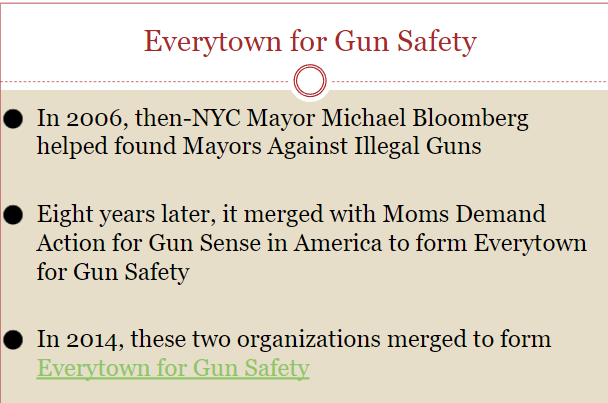 |  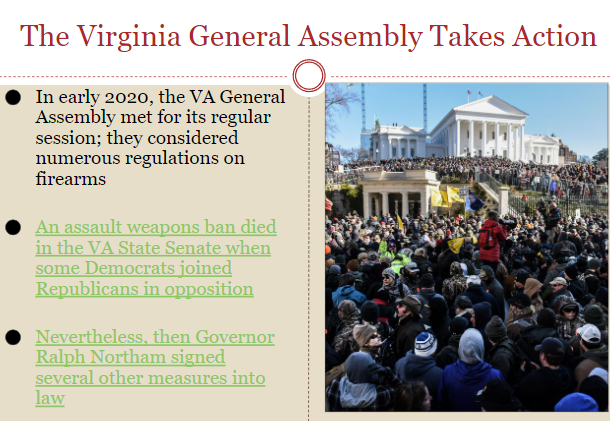 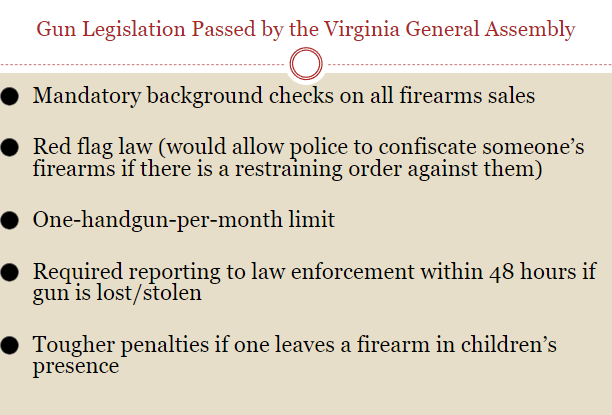 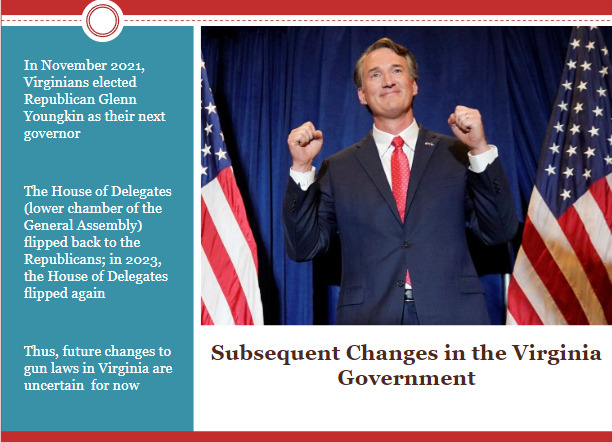 |
- Efforts by UH
2019 | 2023 |
|---|---|
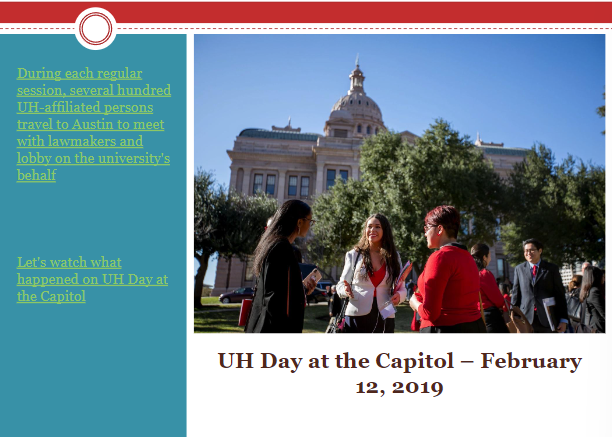 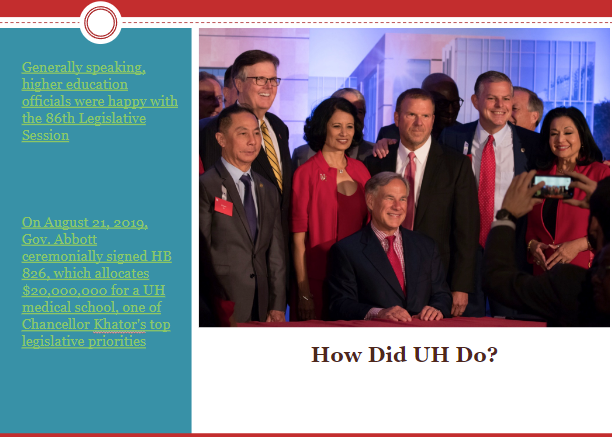 | 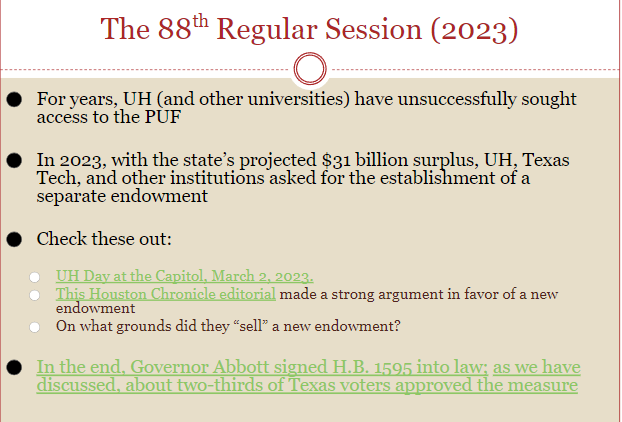 |
FED – Chapter 9: Political Parties (also see slides)
- Political parties vs. interest groups
Political Parties | Interest Grps |
|---|---|
An org, of ideologically similar ppl. that nominates & elects its members to office in order to run the gov’t & shape public policy” (From Hershey 17th ed., p.6) | Individuals who organize to influence the government’s programs and policies ” (from your textbook) |
- Components of political parties:
Electorate | Organizations |
|---|---|
Consists of Americans who identify with one of the political parties | Each political party has organizations at all levels (local, state, federal, etc.) that are engaged in fundraising, GOTV and support candidates on the party’s ballot
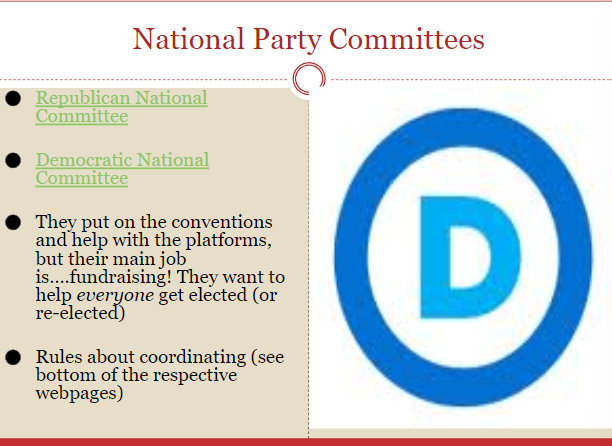 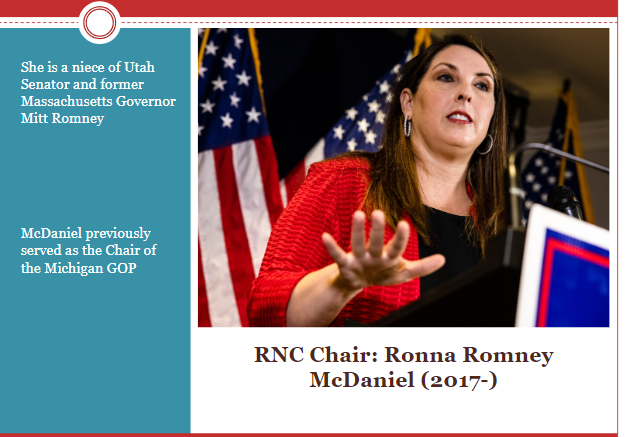  |
Government | |
Party leadership in Congress
Extends all the way down to city and county governments |
- Partisan identification:
Definition | implications (including caveats) |
|---|---|
Sense of psychological attachment that most Americans develop toward a political party” (From Party Politics in America, 13th ed., p. 101)
|
|
Distribution | effects of partisan identification in the United States |
|---|---|
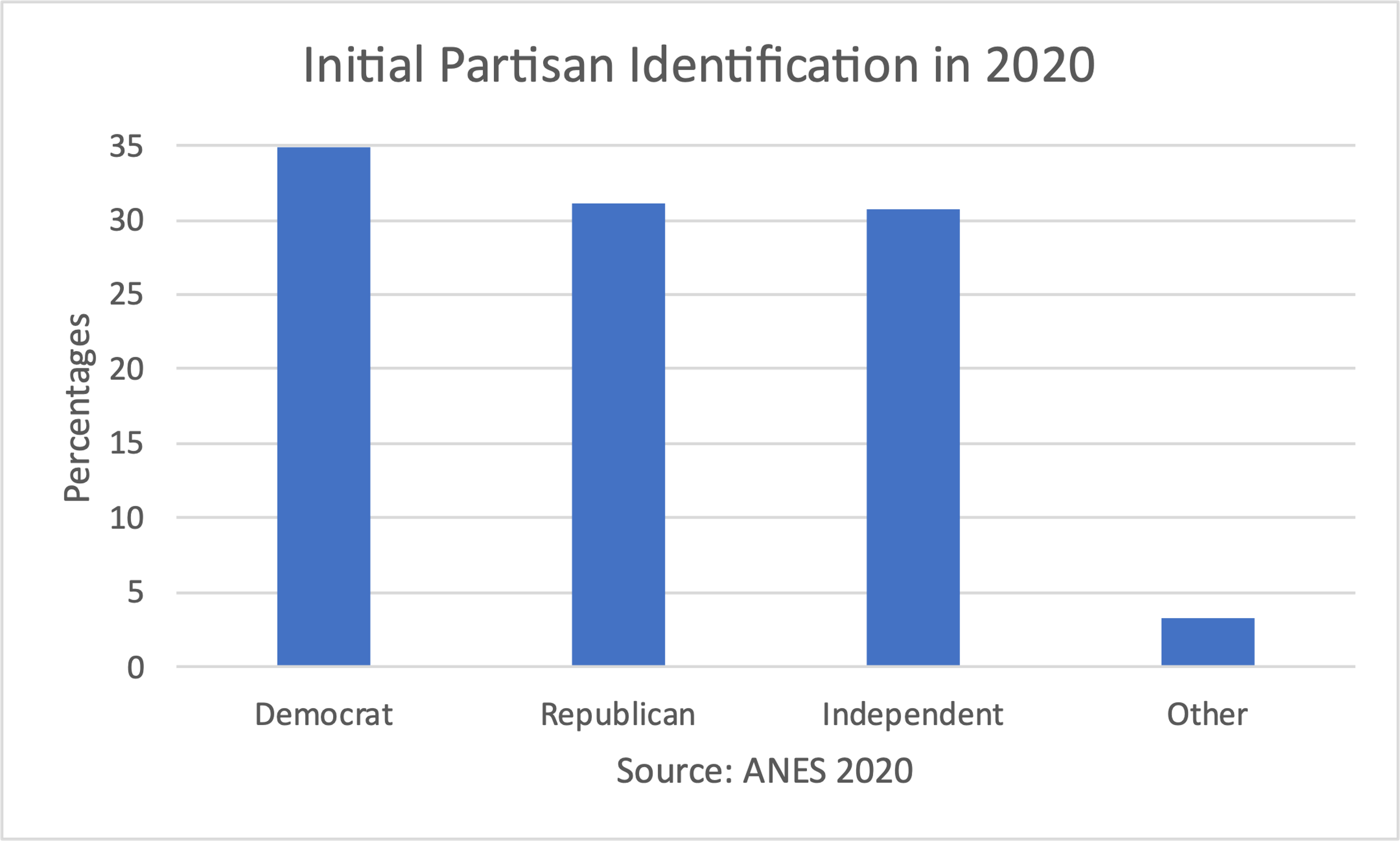 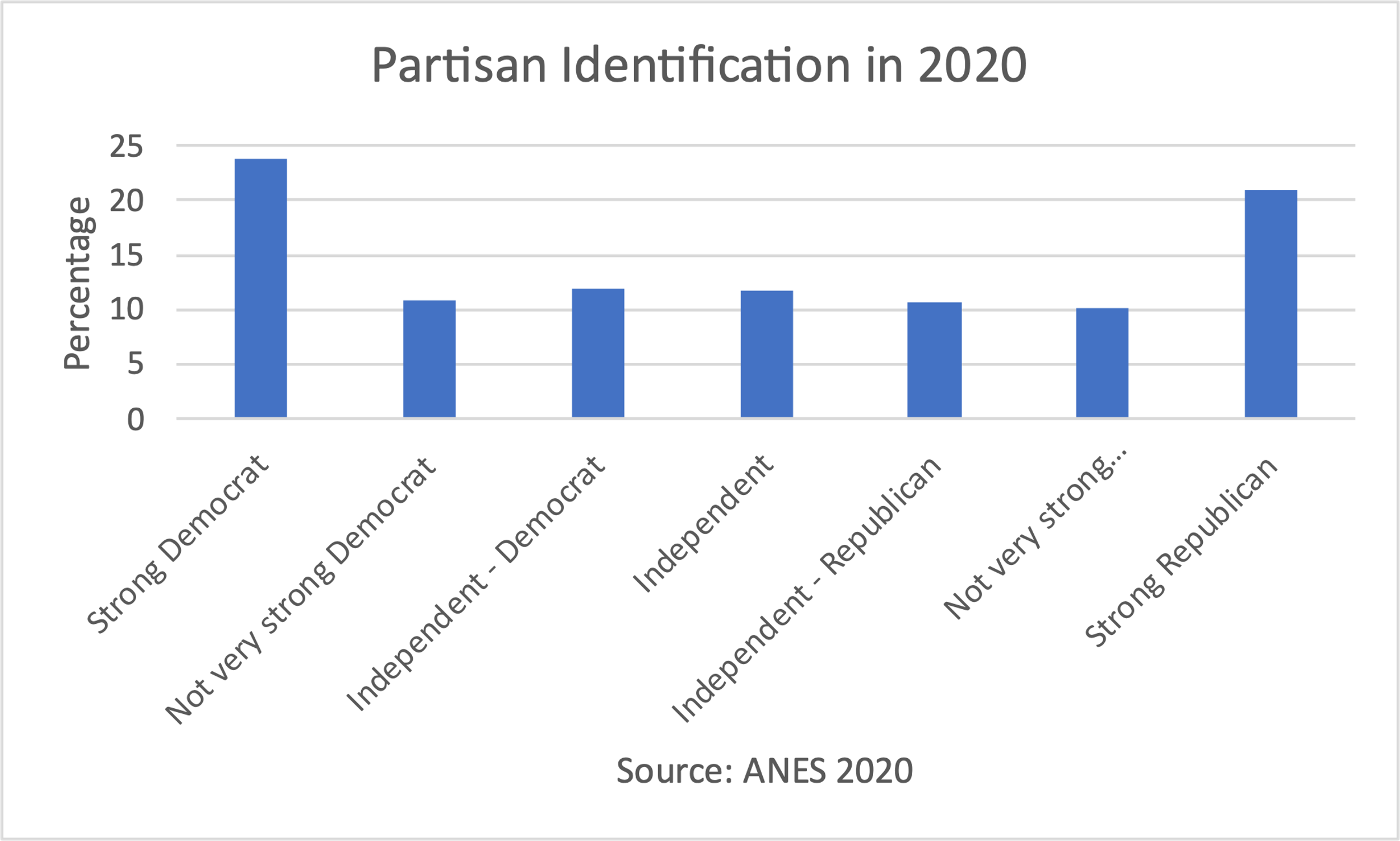 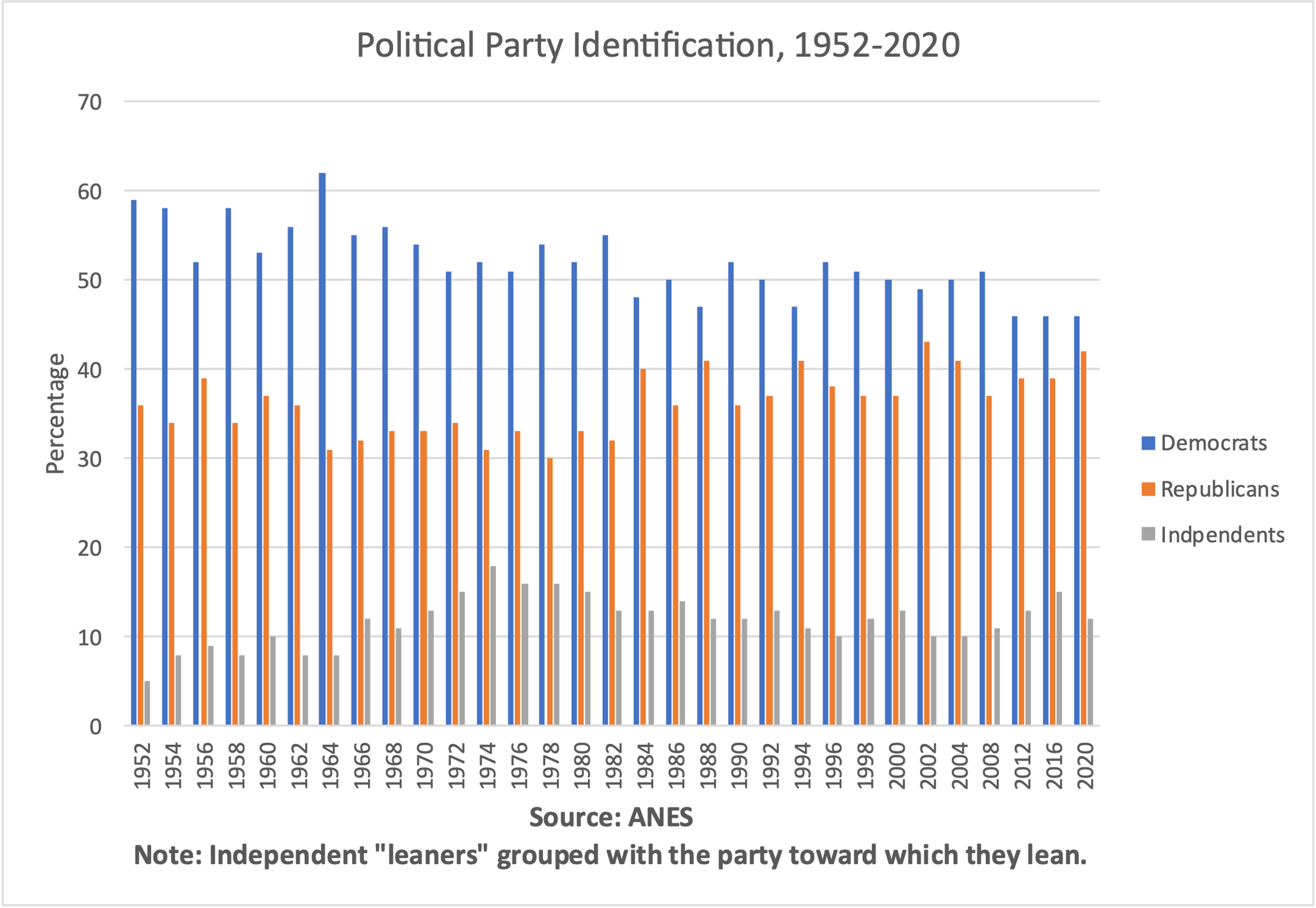 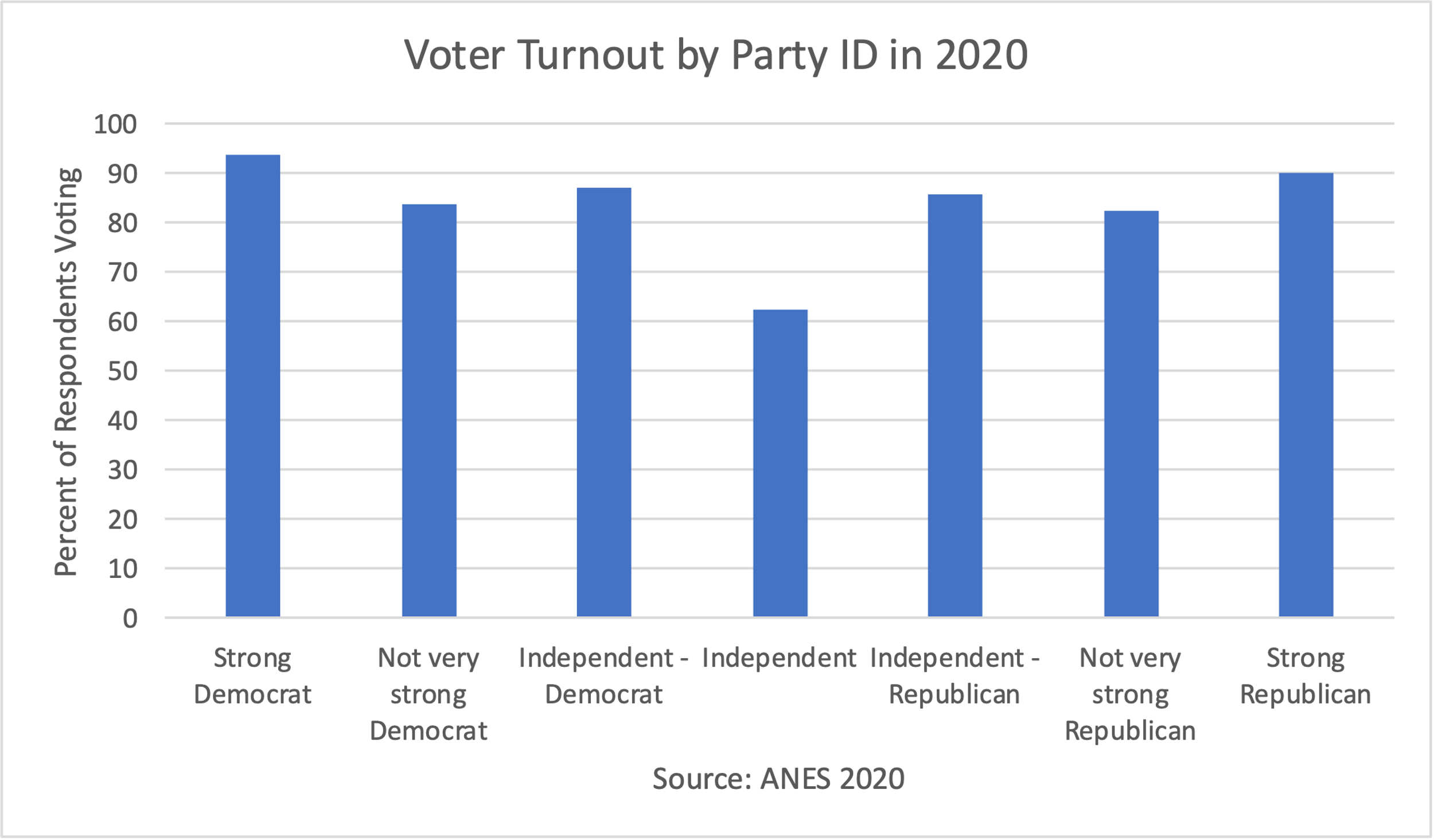 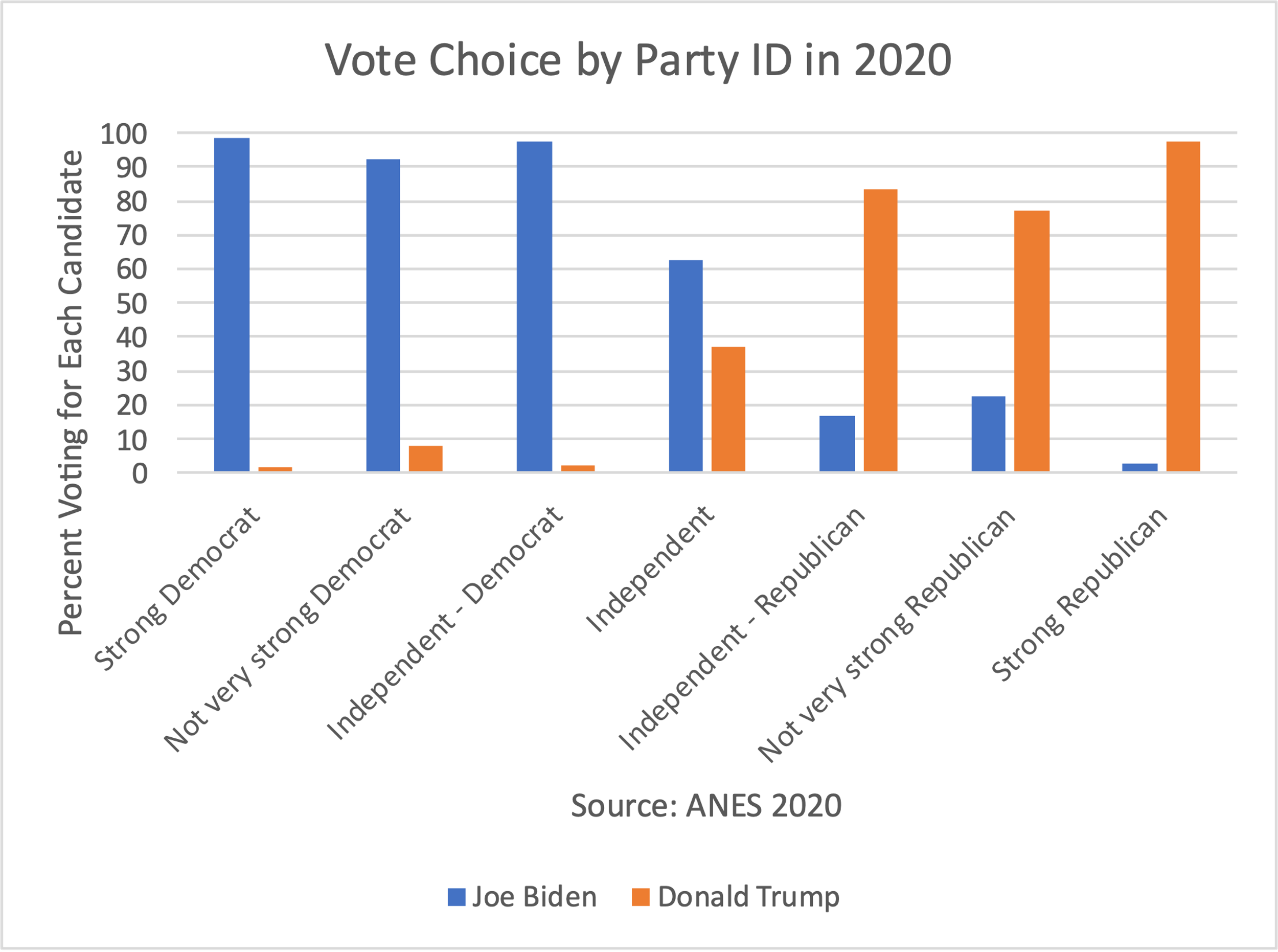 | Compared to Independents, citizens with a party ID, especially a strong one, are more attentive to politics and more likely to vote
|
- Characteristics of political independents
- Value political independence, e.g. “I vote for the person, not the party”
- There is a popular perception that self-proclaimed Independents carefully consider all issues and candidates before making a thoroughly informed vote choice
- Notice from earlier that many people who identify as Independents subsequently acknowledge that they lean toward a major party; therefore, political scientists label them “closet partisans”
- The number of true Independents is far lower, and they are often uninvolved in politics
- Value political independence, e.g. “I vote for the person, not the party”
- Characteristics of political independents
- Two-party system and third parties
- Duverger’s Law
- Single-member districts w/ plurality elections tend to produce 2-party systems” (From Party Politics in America, 13th ed., p. 31)
- Ballot and debate restrictions
- In Texas needed 74,108 signatures to get on ballot for 2008 presidential election
- 43,991 signatures for a new party slate
- Gary Johnson on the rules keeping him off the debate stage
- Duverger’s Law
Reasons third parties struggle for success in the United States | purposes that they serve |
|---|---|
|
|
Ross Perot | Dynamics of 3rd Parties |
|---|---|
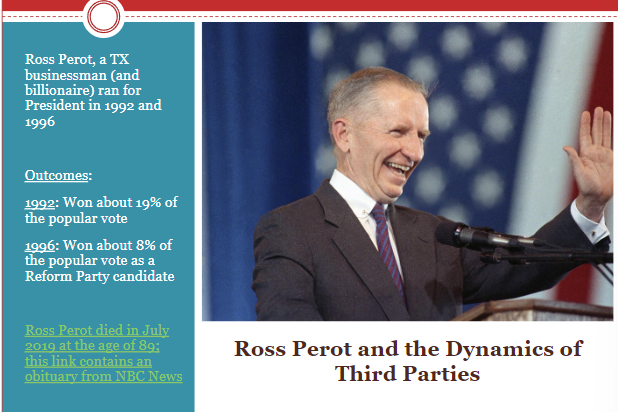 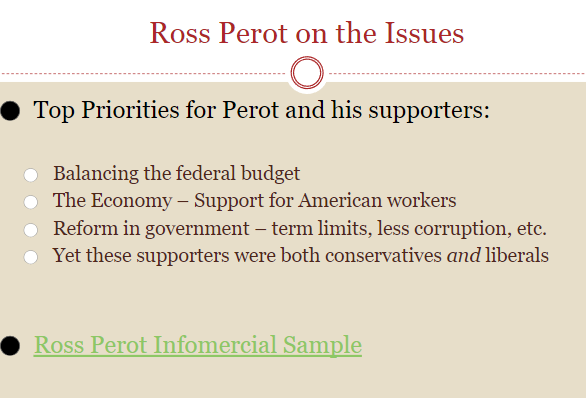 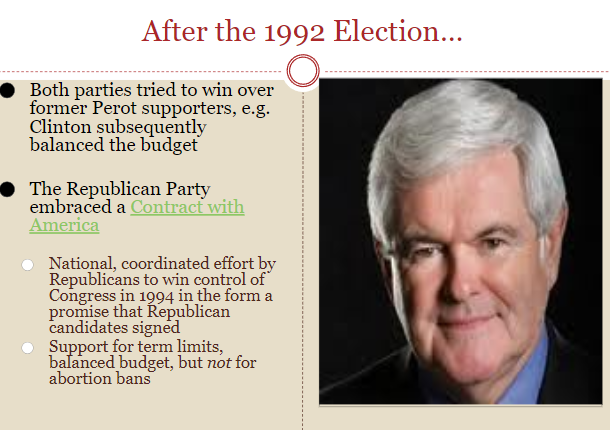 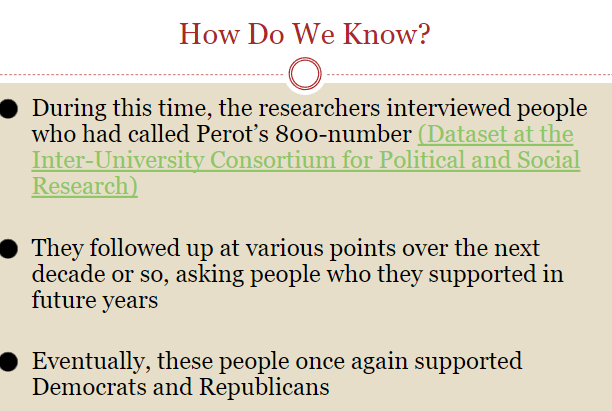 |  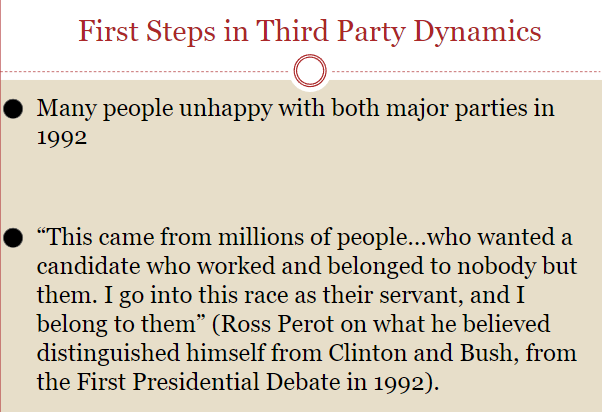 |
- Ralph Nader and the 2000 election
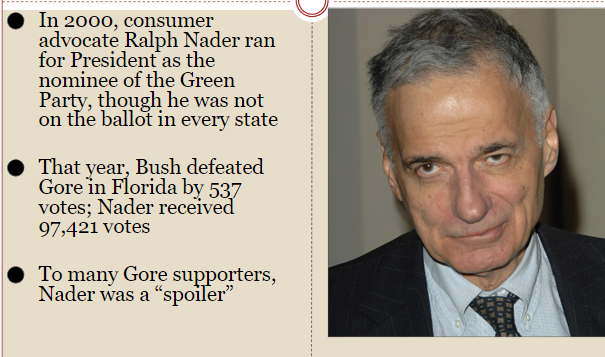
 Knowt
Knowt